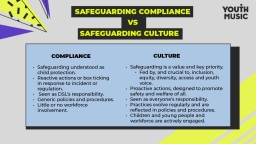Putting the Spotlight on Safeguarding
What is safeguarding and why is it important?
At its core, safeguarding protects people’s health, wellbeing and human rights, enabling them to live free from harm, abuse or neglect. It’s vital to Youth Music’s work, driven by our focus on young people facing barriers.
The number of referrals to children’s social services has been increasing in recent years, to over 650,000 in 21/22. Over 16,000 of these cases were linked to child sexual exploitation and over 10,000 to child criminal exploitation. The Commission for Young Lives says these numbers are ‘just the tip of the iceberg’.
No sector, organisation or individual is immune from the importance of safeguarding. In 2022, the Incorporated Society of Musicians (ISM), Dignity at work 2: Discrimination in the music sector report revealed the extent of discrimination (including sexual harassment and racism) in all areas of the music sector, with 66% of respondents saying they have experienced some form of discrimination while working in the music sector.
Grassroots music projects should be a place where children and young people, and the workforce supporting them, can expect to feel safe and included. That’s why you’ll see safeguarding embedded across our funding programme, from the eligibility criteria, application form and funding agreement to the reporting templates.
Youth Music has long been known for our focus on inclusion. You can’t have good inclusion practices without good safeguarding practices. The two go hand- In-hand; they are mutually reinforcing. When working with people who are excluded because of their circumstances or backgrounds, an inclusive culture that recognises people’s different identities, needs and experiences will prevent different types of normalised harm through discrimination.
“The opportunity for young people to have space to talk, share concerns, and raise issues has significantly increased during the course of this project. This has been enabled by allocating a Lead Youth Worker to each group session. These workers know the young people through other youth work activities, they are part of the core staff of the wider organisation, therefore are up-to-date with safeguarding concerns and the personal circumstances of individual participants. It has been really significant that Music Drop-Ins have given young people a voice, and a safe place to be heard.” - Youth Music Funded Partner
Similarly, a culture of children and young people’s views being heard and responded to means they’ll be more confident to communicate their needs or make disclosures. The same goes for staff and volunteers.
“Our aim is always to have a holistic approach to safeguarding in every sense embedded across the organisation. We see developments in our youth voice practice as being of key importance to this as if children feel safe to share and voice their experiences then they are more likely to bring safeguarding concerns to our attention.” - Youth Music Funded Partner
Youth Music’s new safeguarding requirements
In our recent funding programme refresh, safeguarding has been a focus more than ever before. There are clear minimum standards that organisations should meet, which are based on statutory guidelines. But minimum standards aren’t the full picture. We want to know that safeguarding is embedded into an organisation’s culture and ways of working, as a continuously developing practice.
This is because safeguarding is most effective when it is a culture and mindset. Rather than a “box-ticking” compliance exercise, safeguarding should be a continually evolving practice, part of the culture and DNA of an organisation. What’s more, it should be done with and for the people it’s designed to protect from harm.

Where does the music industry fit into safeguarding?
Some organisations that work solely with people aged 18 years and over may not be legally required to have a safeguarding policy. However, adults can be at risk of harm due to a range of circumstances and experiences, some of which may not be obvious. It’s important that all our funded partners anticipate that some of the people they work with will be at risk of harm.
Whilst safeguarding policies and practices at present are more the domain of charities and the music education sector, the music industries need to become a safer space too. This year’s ‘Be the change’ global research into gender equality in the music industry found that 34% of women had suffered sexual harassment and abuse (rising to 42% and 43% for transgender and non-binary people). A key call to action is to increase availability of safe spaces for creators to perform, promote and perform their work. A new ‘Creative Industries Independent Standards Authority’ is currently being set up to uphold standards of behaviour and prevent and tackle bullying, harassment and discrimination.
Want to know more?
We’ve recently overhauled and updated our Safeguarding Resource Hub, a one-stop-shop that will signpost you to the most useful resources, no matter what the stage of your safeguarding journey.
